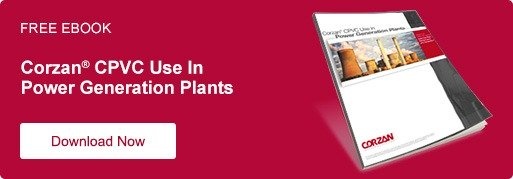Corzan® CPVC Keeps Boiler Feed Water Pure in Power Generation Plants
According to the U.S. Geological Survey, power generation plants are the largest source of U.S. water withdrawals and account for about 40 percent of the total water withdrawn from various sources in the United States.
Plant facilities withdraw water from rivers, oceans, lakes and other sources to cool equipment while generating electricity. Following withdrawal, the water is either lost to evaporation or blowdown during generation, or it is diverted or discharged back into a body of water and is cleaner than when it was withdrawn.
Boiler Feed Water Systems Require Pure Water
Boiler feed water systems treat and transport water to the boiler, which creates the steam required to turn the generator turbines. Feed water must be ultra-pure to ensure the long-term reliability of the turbine blades and to prevent corrosion and scale that could weaken the blades. The need for piping systems that will not react with the water supply nor contribute leachable ions into the water are critical to ensure the long-term success of the boiler and turbine systems. This is why the industry is turning to Corzan® CPVC (chlorinated polyvinyl chloride) piping systems.
Power generation facilities often use harsh chemicals such as sodium hypochlorite, caustic soda, and sulfuric acid as part of their water treatment systems. Boiler feed water treatment involves effectively and reliably delivering chemicals to remove corrosive substances, balance pH levels and limit boiler water conductivity. Treatment chemicals such as sulfite-based oxygen scavengers remove any trace of oxygen, which is a catalyst for corrosion. Phosphates added to the boiler feed water stream bind calcium ions and keep them from binding to metal parts, which can result in scaling.
The material used for tank liners and piping systems where treatment chemicals are stored and delivered is very important. Corzan CPVC’s nonmetallic construction eliminates corrosion and scaling along with the possibility of re-introducing metal into the feed water stream after treatment. Corzan CPVC is also significantly more cost effective than stainless or even carbon in many applications.
CPVC for Cooling Water Loop Circulation
After turning the generator turbines, steam must be cooled to convert it back to a liquid. This cooling process also helps to limit heat transfer to the surrounding environment, which satisfies regulations and improves plant efficiency.
Water cooling in most plants is accomplished by passing the steam across pipes circulating colder water in a flue, stack or condenser. It is not uncommon in nuclear facilities and other operations to also have a need for double containment systems, which are readily available using Corzan CPVC technology. The cooling system is usually one of the following:
- Once-through system that pulls water from a nearby source, circulates it through the steam and then pumps it back into the water source – only a few degrees warmer.
- Wet recirculating or closed-loop system that cools the steam-heated water by exposing it to ambient air, often blowing it against the water flow. In larger plants (10+MW). This process occurs in a cooling tower that may be located up to a kilometer away. Smaller plants usually feed the water through a chiller system.
Both types of cooling systems require a piping material that is light weight and easy to install, which can significantly impact installation cost and maintenance. Metal piping can be six times as heavy as non-metallic piping such as Corzan CPVC and requires hot joint welding by highly trained workers with cumbersome equipment, which can become very time-consuming and costly when installing piping systems throughout a building or over a long distance.
CPVC is joined with mechanical joints or solvent cement, easing installation and reducing costs overall. In addition, solvent-cemented joints become the strongest part of the system -- stronger than either the piping material or fittings alone.
Wet Scrubber Applications
Wet scrubbers clean or purify air by removing gasses, particulates and other harmful compounds from a system’s emissions. Power generation plants require scrubbers and combustion vents to remove particulates from the generator or boiler. Coal power plants, for example, rely on scrubbers to remove sulfur dioxide emissions from exhaust gas.
The scrubbers use continuous sprays of neutralizing fluids to control harmful emissions. These fluids are usually lime-based or sodium hydroxide caustic fluids, which can corrode materials such as stainless steel. Neutralizers can also form condensation on the inside wall of metal scrubber tanks, resulting in pitting corrosion over time.
Power generation plants can benefit from the chemical compatibility of Corzan CPVC, which improves the wet scrubber’s performance and overall lifespan. Corzan CPVC can withstand harmful chemicals with limited degradation and may be used in the venting duct, chemical delivery, the scrubber tank and drain piping. Corzan CPVC is pressure rated for operations up to 200°F (93°C) and will maintain its pressure-bearing capabilities for long durations.
Corzan CPVC Offers History of Success
Corzan Industrial Systems have over 60 years of providing reliable service in industrial facilities such as power generation plants. Corzan CPVC offers an excellent balance of properties to improve reliability and reduce capital and lifecycle costs while, most importantly, ensuring power generation plants remain operational and productive.
Corzan CPVC offers these specific advantages for power generation plants:
- Eliminates internal and external corrosion
- Reduces installation time and costs
- Ensures lower lifecycle costs
- Provides excellent hydraulic capabilities
- Facilitates installation and maintenance because parts are available locally
In addition, Corzan CPVC piping is offered in diameters up to 24 inches to satisfy most power plant requirements. Contact us for a free power generation suitability and technical consultation.
Some of the information for this blog came from the Corzan CPVC Use in Power Generation Plants brochure. Please reference for more details.


